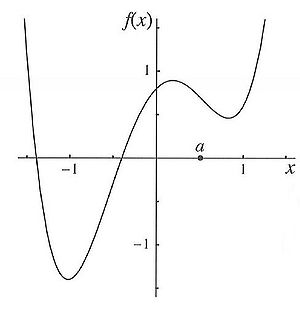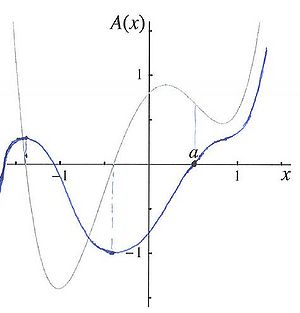Science:Math Exam Resources/Courses/MATH103/April 2013/Question 09
{{#incat:MER QGQ flag|{{#incat:MER QGH flag|{{#incat:MER QGS flag|}}}}}}
• Q1 (a) • Q1 (b) • Q1 (c) • Q1 (d) • Q1 (e) • Q1 (f) • Q2 (a) • Q2 (b) • Q2 (c) • Q2 (d) • Q3 (a) • Q3 (b) i • Q3 (b) ii • Q4 (a) • Q4 (b) • Q5 (a) • Q5 (b) • Q6 (a) • Q6 (b) • Q6 (c) • Q7 (a) • Q7 (b) • Q7 (c) • Q7 (d) • Q7 (e) • Q8 (a) • Q8 (b) • Q8 (c) • Q9 • Q10 •
Question 09 |
|---|
|
Sketching Antiderivatives Consider the sketch below. Provide a sketch of the antiderivative for . Make sure to clearly indicate local maxima and minima of |
|
Make sure you understand the problem fully: What is the question asking you to do? Are there specific conditions or constraints that you should take note of? How will you know if your answer is correct from your work only? Can you rephrase the question in your own words in a way that makes sense to you? |
|
If you are stuck, check the hints below. Read the first one and consider it for a while. Does it give you a new idea on how to approach the problem? If so, try it! If after a while you are still stuck, go for the next hint. |
Hint 1 |
|---|
|
There are three key values to note - what happens at a and what happens at the two locations where the function goes from positive to negative? |
Hint 2 |
|---|
|
Don't forget, if you start at a and go left you actually get more negative since integrals also encode a sense of direction. |
Hint 3 |
|---|
|
Your function should be smooth (meaning differentiable everywhere - so no corners allowed!) |
|
Checking a solution serves two purposes: helping you if, after having used all the hints, you still are stuck on the problem; or if you have solved the problem and would like to check your work.
|
Solution |
|---|
|
Attached is a picture. Notice that there is a local minimum at and a local maximum at . Also note that plugging in a into the integral gives . |
{{#incat:MER CT flag||
}}









